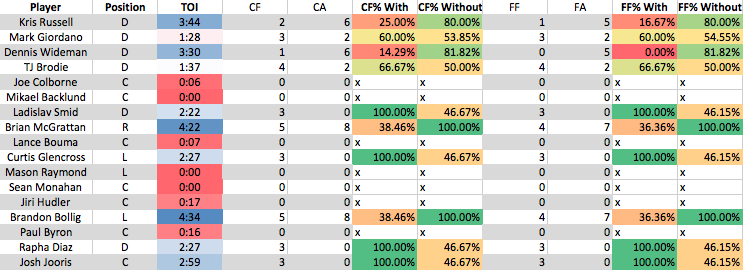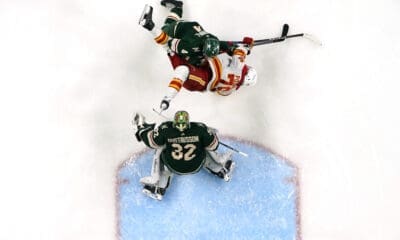Calgary Flames
The morning after: Game six fancy stats recap
Jooris performed well in his NHL debut, but he got a lot of help, starting almost exclusively in the offensive zone. Still, it paid off for him, and that's never a bad thing.

It wasn’t a bad game. It started off that way, but eventually, the Flames were able to turn it around. They just waited too late to do it, but this is game five of a six-game road trip; a road trip that’s been plagued by the flu and has had its fair share of wacky moments and percentages already. And while the Blue Jackets completely dominated for long stretches, the Flames had their fair share of chances, too.
It's cool that a lot of them were sparked by a rookie, who brought real, genuine enthusiasm to the game, and was wonderfully rewarded for it. And besides, this is just year two of a rebuild. Moral victories still mean something here.
The Flames were definitely outplayed, but managed to even it up by the end (well, except on the scoreboard, but they were so close to their third overtime game in three games). Via HockeyStats:
So, every period the Flames fell behind, and every period they got themselves back in it. It reflects in the score: the game never turned into the blowout it looked like it might have become. And they were a goalpost away from tying it up. Period by period analysis from NaturalStatTrick:
Flames at Blue Jackets - All Situations

Flames at Blue Jackets - Even Strength

Even Strength Corsi Data
- Josh Jooris is the obvious standout here, and rightfully so. He had an excellent debut. A sheltered, excellent debut, since he had the second highest zone starts out of the entire team, and I’m pretty sure he didn’t start a single shift in the neutral or defensive zones until the third period. Great numbers, but remember, there’s a strong context for them, and he isn’t likely to repeat.
- As for his most frequent linemates, Sean Monahan and Jiri Hudler got slightly better zone starts, but were unable to maintain Jooris’ numbers. That’s because they faced tougher competition than Jooris. Still, those zone starts clearly helped them: they had some of the best numbers on the team largely because of them.
- Continuing with the high offensive zone starts theme, Brian McGrattan and Brandon Bollig were sheltered, but not quite as heavily so. Still, they put up some of the worst possession numbers on the team. McGrattan and Bollig played 5:46 and 5:56 respectively, and didn’t see a second of ice time in the third, when the Flames had their best period. Hartley didn’t trust them to take part in the comeback, and rightfully so.
- Jumping around a bit, Lance Bouma had the worst numbers, but that’s with a return from injury and much weaker zone starts. He had the third least amount of ice time, but was the most frequent forward on the penalty kill (this doesn’t factor into the chart, it’s just interesting to note).
- Lowest zone starts: Paul Byron and Mikael Backlund. They were, predictably, under par for the team, but did a pretty formidable job considering what they were given. It’s great to see they’re sticking together as a pair, too, because they work really well with one another.
- Curtis Glencross, meanwhile, did really well with his ice time, and was one of the top Fenwick players with it. He most frequently played with Byron and Backlund, but shared time with Stajan, Monahan, and Jooris as well. Stajan and Jooris in particular bolstered him.
- Considering his zone starts, Joe Colborne didn’t perform particularly well. He wasn’t as bad as McGrattan or Bollig, but he was next in line. His most common linemate, Mason Raymond, had a better performance despite spending more time out of the offensive zone. And while Raymond’s numbers really aren’t anything remarkable, I really like him as a free agent pickup.
- Defencemen! Ladislav Smid and Raphael Diaz got the worst starts. Smid broke even, but played the least; Diaz was finally given a bit more trust, and put forward a respectable effort.
- Kris Russell and Dennis Wideman were the sheltered pair, zone start-wise, and did not have as great a performance; that said, they both played over 20 minutes, so they had more to work with. Wideman was more sheltered than Russell, and the stats say Russell did far better when he was separated from his defence partner. Wideman did better away from Russell as well, and even Smid and Diaz seemed to have increased performance when not playing with one another. Small sample size, but maybe further experimentation with a partner swap is in order?
- Last but never least, Mark Giordano and TJ Brodie were given slightly favourable zone starts, but also faced the toughest competition, and while they got burned on Columbus’ first goal, were by far the best defensive pairing. Of course they were. They always are. They had four shots apiece and played 24~25 minutes, too.
Player Spotlight - Matt Stajan
And then there's Stajan, he whose percentages shot way up. He saw much more playing time – 13:35 minutes – than normal, with his usual linemates benched for the entire comeback period. This gave Stajan the chance to play in more difficult circumstances with players who can match his skill set, and, well, took a look for yourself as to how he did:

So yeah. Small sample size, but very, very clear pattern. Matt Stajan is not a fourth liner, so don't play him with them.
by Ari Yanover









